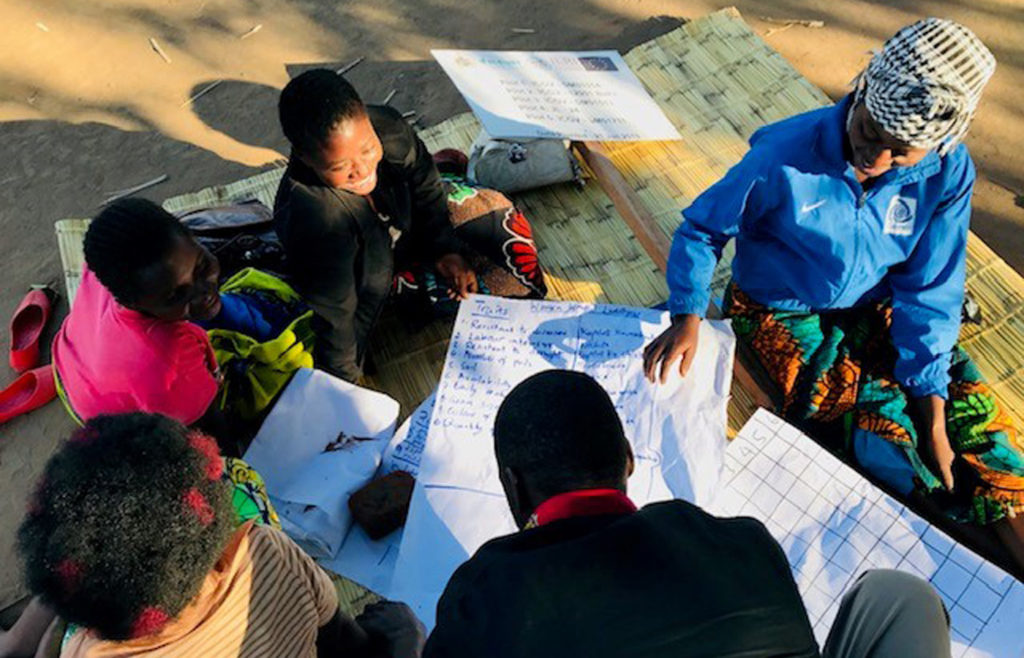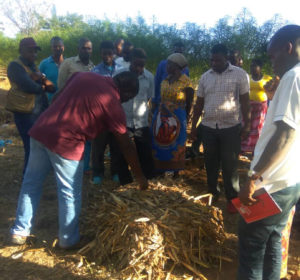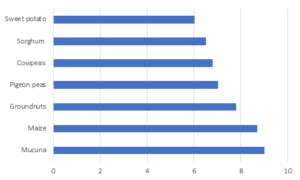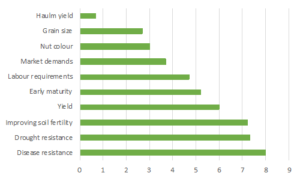
Farmers scoring traits of crop residues. Photo: Sabine Homann-Kee Tui
In the context of small land holdings in Malawi, would the use of crop by-products and residues hold the key to sustainable livestock production? With erratic rains resulting in production of only the vegetative part of the crop, would its use as feed be of use in times of adversity? While most farmers in Naweta village, Balaka district, Malawi, agreed that grain biomass was important for livestock feed, several suggested growing crops specifically for the livestock to increase the livestock feed base.
Establishing fodder markets was seen as a possible source of income wherein farmers without livestock could sell the biomass to those with livestock.
Farmers’ perception of crops and crop residues was investigated during a participatory variety selection exercise on 3 June, 2019 at Naweta Village in Utale EPA in Balaka District. The participants included 14 men and women farmers with and without livestock
Which crops are important to feed livestock?
- Mucuna, though only grown on small pieces of land, scored the highest rating. Considering the high biomass and feed quality of Mucuna, it represents an important, yet undervalued feed resource.
- Maize residues scored high. Being the predominant crop, they are a readily available source of feed. Maize improvement should focus on food and feed values.
- Groundnut, pigeonpea and cowpea also scored relatively high as farmers recognized the feed value of the biomass and haulms. Women in particular tended to attribute less importance to the feed value, often using the biomass as relish.
How important are feed traits in groundnuts
Groundnut residues have high feed nutritional values, with relatively high protein content. However, although farmers scored feed as important, they were mostly concerned with ensuring a harvest from groundnuts. For them, drought resistance and disease resistance were most important traits. Soil fertility improvement also ranked high. For women, labor saving was also important. Attribution of feed value was of secondary importance to them.
What does this mean?
In Malawi, where crop-livestock integration has not been a great priority, the attribution to feed and fodder is changing. Farmers are now perceiving greater importance of crop residues for feed. In this era of shrinking land holdings, that is the way to go.
Crop residues hold a substantial stake in ensuring sustainable livestock production. Attribution of high value to crop residues as livestock feed will help address the feed shortages experienced in the area during dry seasons. Farmers with livestock can produce more biomass for feed on the same piece of land that they produce their crops on; those without livestock can use the residues as a source of income by selling them to those with livestock.

Farmers comparing groundnut varieties in terms of haulm yield. Photo: Sabine Homann-Kee Tui
High value crops like groundnut require substantial investment in seed and other costs, while also carrying a high risk of losing the harvest to dry spells or diseases. Risk traits, like disease resistance and drought tolerance, are more important to farmers than yield traits. Farmers’ decisions are driven by avoidance of risk; once risk is addressed, yield is a secondary outcome.

Crop residues processing training. Photo: Claire Mwamadi
Farmers therefore will invest in dual-purpose groundnuts for food and feed only if the other aspects – disease resistance and short duration – are taken care of. There is need to promote dual-purpose varieties that fulfill the traits that farmers look for, along with increased grain and biomass production, as they integrate crop and livestock production.
Genetic variability of crops suggests that improved varieties can be found that combine primary and secondary traits. With decreasing availability of land and water, against an increasing feed demand, cost-effective sources of feed need to be identified. Crop residues will play an important role in this.
About CLIM2
The project on Improved livelihoods through sustainable intensification and diversification of market-oriented crop-livestock systems in southern Malawi (CLIM2) is working to strengthen diversification and integration in crop-livestock farming systems in three districts of Malawi. The project is funded by the European Union under the Farm Income Diversification Programme (FIDP) Phase II – Agribusiness. The project is implemented by the International Crops Research Institute for the Semi-Arid Tropics (ICRISAT) as the lead agency, in collaboration with the International Livestock Research Institute (ILRI) and Small-Scale Livestock and Livelihoods Programme (SSLLP); and several departments within the Malawi Ministry of Agriculture, Irrigation and Water Development.
About the Author

Donald Kaonga,
PhD student, International Livestock Research Institute.




Add Comment